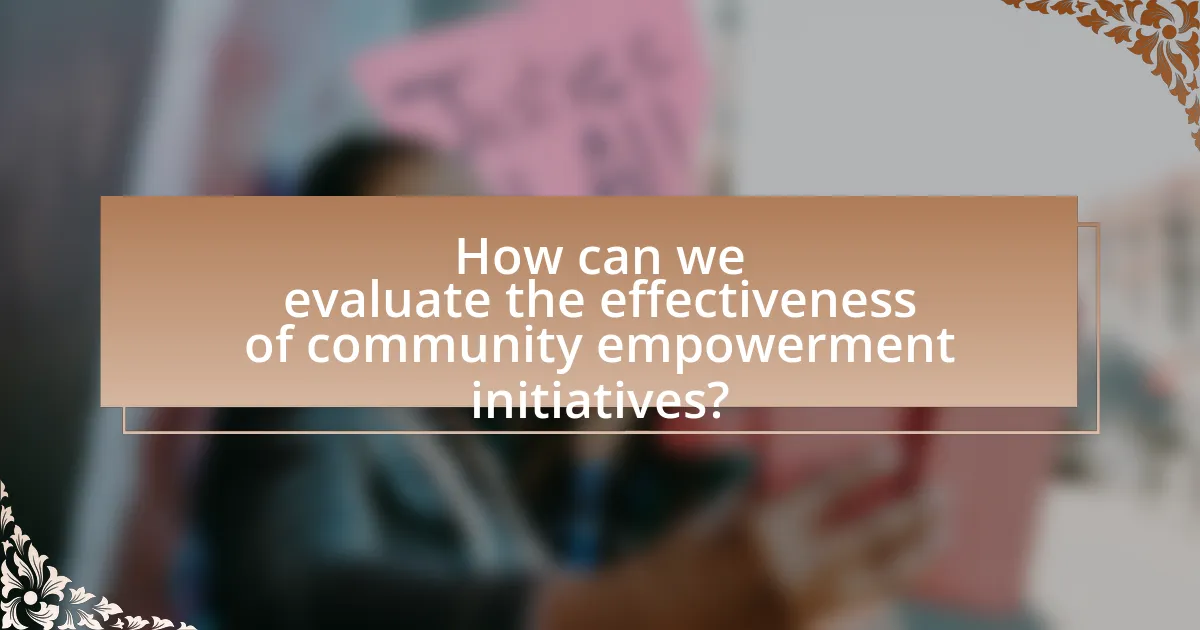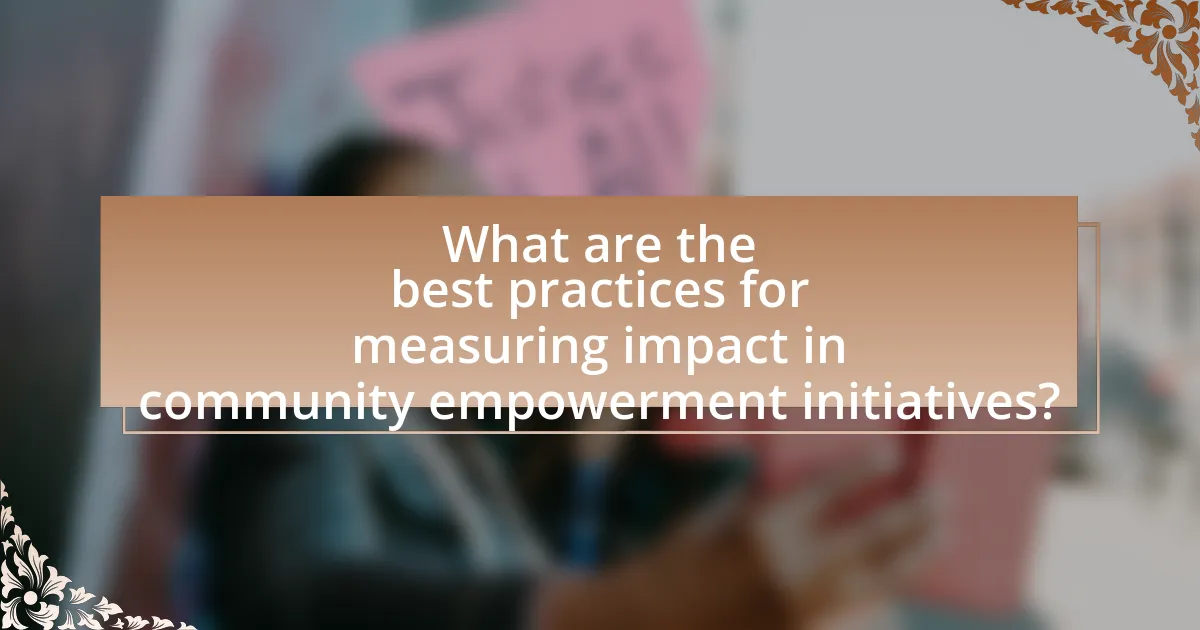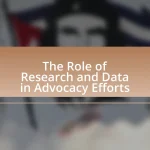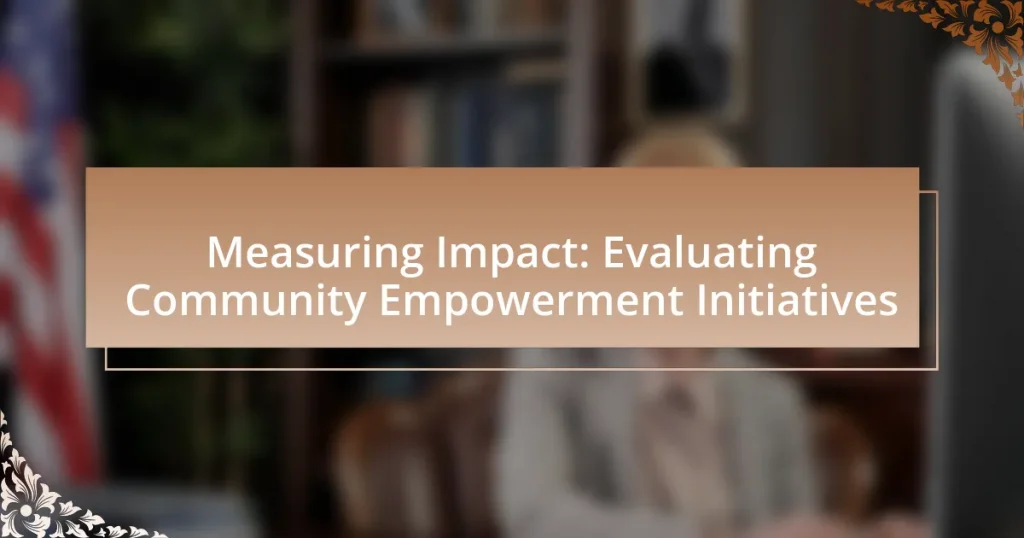Measuring impact in community empowerment initiatives involves systematically assessing the outcomes and changes resulting from these initiatives on individuals and communities. The article defines community empowerment initiatives as organized efforts to enhance the capacity of community members to make decisions and take actions that affect their lives. Key characteristics of effective initiatives include inclusivity, capacity building, and sustainability. The importance of measuring impact is emphasized, as it provides evidence of effectiveness and informs decision-making. Various methodologies, including quantitative and qualitative approaches, are discussed for evaluating impact, alongside the challenges faced in measurement, such as bias and limitations of existing frameworks. The article also outlines best practices for measuring impact, including stakeholder engagement and continuous learning, to enhance the sustainability and effectiveness of community empowerment initiatives.

What is Measuring Impact in Community Empowerment Initiatives?
Measuring impact in community empowerment initiatives refers to the systematic assessment of the outcomes and changes resulting from these initiatives on individuals and communities. This process involves collecting and analyzing data to evaluate how effectively the initiatives have enhanced community members’ skills, resources, and overall well-being. For instance, a study by the World Bank found that community-driven development projects significantly improved local governance and increased access to services, demonstrating measurable benefits in community empowerment.
How do we define community empowerment initiatives?
Community empowerment initiatives are defined as organized efforts aimed at increasing the capacity of individuals and groups within a community to make decisions and take actions that affect their lives. These initiatives often focus on enhancing skills, fostering leadership, and promoting social justice, thereby enabling community members to engage actively in civic processes. Research indicates that successful community empowerment initiatives lead to improved social cohesion and increased participation in local governance, as evidenced by studies showing that communities with strong empowerment programs experience higher levels of civic engagement and better overall well-being.
What are the key characteristics of effective community empowerment initiatives?
Effective community empowerment initiatives are characterized by inclusivity, capacity building, and sustainability. Inclusivity ensures that diverse community voices are heard and represented, fostering a sense of ownership among participants. Capacity building focuses on enhancing the skills and resources of community members, enabling them to take charge of their development. Sustainability involves creating long-term strategies that allow initiatives to continue benefiting the community beyond initial funding or support. Research indicates that initiatives incorporating these characteristics are more likely to achieve lasting positive outcomes, as evidenced by studies showing increased community engagement and improved quality of life metrics in empowered communities.
Why is measuring impact important for these initiatives?
Measuring impact is crucial for community empowerment initiatives because it provides evidence of effectiveness and informs decision-making. By quantifying outcomes, stakeholders can assess whether the initiatives are achieving their intended goals, such as improving community well-being or increasing participation. For instance, a study by the Stanford Social Innovation Review found that organizations that measure their impact are 50% more likely to achieve their objectives compared to those that do not. This data-driven approach enables continuous improvement and accountability, ensuring resources are allocated efficiently and effectively.
What methodologies are used to measure impact?
Quantitative and qualitative methodologies are used to measure impact in community empowerment initiatives. Quantitative methodologies include surveys, statistical analysis, and metrics such as pre- and post-intervention assessments, which provide numerical data on changes in community conditions. Qualitative methodologies involve interviews, focus groups, and case studies that capture personal experiences and narratives, offering deeper insights into the effects of initiatives. Research has shown that combining both methodologies enhances the understanding of impact by providing a comprehensive view of both measurable outcomes and personal stories, as evidenced by studies in community development literature.
How do qualitative and quantitative methods differ in measuring impact?
Qualitative and quantitative methods differ in measuring impact primarily in their approach and data type. Qualitative methods focus on understanding the underlying reasons, motivations, and experiences of individuals through interviews, focus groups, and observations, providing rich, descriptive insights into community empowerment initiatives. In contrast, quantitative methods utilize numerical data and statistical analysis to measure impact through surveys, experiments, and metrics, allowing for generalizable conclusions and comparisons across larger populations. For instance, a study might use qualitative interviews to explore community members’ perceptions of empowerment, while simultaneously employing quantitative surveys to assess changes in participation rates, demonstrating the complementary nature of both methods in evaluating impact.
What role do surveys and interviews play in impact measurement?
Surveys and interviews are essential tools in impact measurement as they gather qualitative and quantitative data directly from stakeholders. These methods enable organizations to assess the effectiveness of community empowerment initiatives by capturing participants’ experiences, perceptions, and outcomes. For instance, surveys can quantify changes in knowledge or behavior, while interviews provide deeper insights into personal stories and contextual factors influencing those changes. Research indicates that using both methods enhances the validity of findings, as they complement each other by providing a comprehensive view of the impact.
What challenges are faced in measuring impact?
Measuring impact faces several challenges, including defining clear metrics, establishing causality, and accounting for external variables. Clear metrics are essential for assessing outcomes, yet they can be difficult to establish due to the complexity of community empowerment initiatives. Establishing causality is challenging because multiple factors can influence outcomes, making it hard to attribute changes directly to specific initiatives. Additionally, external variables, such as socio-economic conditions or cultural differences, can affect results, complicating the measurement process. These challenges highlight the need for robust methodologies and frameworks to accurately evaluate the impact of community empowerment initiatives.
How can bias affect the measurement of impact?
Bias can significantly distort the measurement of impact by skewing data collection and interpretation processes. When evaluators hold preconceived notions or preferences, they may selectively gather information that supports their views while ignoring data that contradicts them. For instance, a study published in the Journal of Community Psychology found that evaluators’ biases can lead to overestimating the effectiveness of community programs when they have a personal stake in the outcomes. This selective reporting can result in misleading conclusions about the true impact of initiatives, ultimately affecting funding, policy decisions, and community trust.
What are the limitations of existing measurement frameworks?
Existing measurement frameworks for evaluating community empowerment initiatives often lack comprehensiveness, leading to incomplete assessments of impact. These frameworks typically focus on quantitative metrics, which can overlook qualitative aspects such as community engagement and individual experiences. Additionally, many frameworks do not account for contextual factors, such as cultural differences or local needs, which can skew results and limit applicability across diverse settings. Furthermore, existing frameworks may rely on outdated methodologies that fail to capture the dynamic nature of community empowerment, resulting in a static view of progress. This limitation is evident in studies that highlight the need for adaptive measurement approaches that reflect real-time changes and community feedback.

How can we evaluate the effectiveness of community empowerment initiatives?
To evaluate the effectiveness of community empowerment initiatives, one can utilize a combination of qualitative and quantitative methods, including surveys, interviews, and participatory assessments. These methods allow for the collection of data on community members’ perceptions of empowerment, changes in social capital, and improvements in individual and collective agency. For instance, a study by the World Bank in 2015 demonstrated that communities engaged in empowerment initiatives reported a 30% increase in participation in local decision-making processes, indicating a measurable impact on community engagement and empowerment. Additionally, tracking specific indicators such as access to resources, educational attainment, and health outcomes can provide concrete evidence of the initiatives’ effectiveness.
What indicators are most relevant for evaluation?
The most relevant indicators for evaluation in community empowerment initiatives include participation rates, changes in knowledge and skills, and improvements in community well-being. Participation rates measure the extent of community involvement in initiatives, which is crucial for assessing engagement and ownership. Changes in knowledge and skills indicate the effectiveness of training and educational components, reflecting the capacity building within the community. Improvements in community well-being can be assessed through metrics such as health outcomes, economic stability, and social cohesion, providing a comprehensive view of the initiative’s impact. These indicators are supported by research showing that active participation and skill development lead to sustainable community improvements, as evidenced by studies in community development literature.
How do we select appropriate indicators for specific initiatives?
To select appropriate indicators for specific initiatives, it is essential to align them with the goals and objectives of the initiative. This alignment ensures that the indicators effectively measure the intended outcomes and impacts. For instance, if an initiative aims to improve community health, relevant indicators might include the reduction in disease prevalence or increased access to healthcare services. Research indicates that using the SMART criteria—Specific, Measurable, Achievable, Relevant, and Time-bound—can enhance the selection process, ensuring that indicators are not only relevant but also practical for evaluation. This method has been validated in various studies, demonstrating that well-defined indicators lead to more accurate assessments of initiative effectiveness.
What are the common metrics used to assess community empowerment?
Common metrics used to assess community empowerment include participation rates, access to resources, and decision-making influence. Participation rates measure the extent of community involvement in initiatives, indicating engagement levels. Access to resources evaluates the availability and utilization of essential services, reflecting the community’s capacity to meet its needs. Decision-making influence assesses the degree to which community members can affect policies and practices, demonstrating their power and agency. These metrics provide a comprehensive framework for evaluating the effectiveness of community empowerment initiatives.
What role does stakeholder feedback play in evaluation?
Stakeholder feedback is crucial in evaluation as it provides insights into the effectiveness and relevance of community empowerment initiatives. This feedback helps evaluators understand the perspectives, needs, and experiences of those directly affected by the initiatives, ensuring that evaluations are grounded in real-world contexts. For instance, studies have shown that incorporating stakeholder feedback can lead to more accurate assessments of program impact, as it highlights areas for improvement and success that may not be evident through quantitative data alone. By actively engaging stakeholders, evaluators can enhance the credibility and utility of their findings, ultimately leading to more informed decision-making and better outcomes for the community.
How can community members contribute to the evaluation process?
Community members can contribute to the evaluation process by actively participating in data collection, providing feedback, and sharing their experiences related to the initiatives. Their involvement ensures that the evaluation reflects the community’s perspectives and needs, which enhances the accuracy and relevance of the findings. For instance, studies have shown that community engagement in evaluation leads to more comprehensive insights, as evidenced by the Community-Based Participatory Research model, which emphasizes collaboration between researchers and community members to improve health outcomes. This collaborative approach not only validates the evaluation process but also fosters a sense of ownership among community members, ultimately leading to more effective empowerment initiatives.
What methods can be used to gather stakeholder feedback effectively?
Surveys and interviews are effective methods to gather stakeholder feedback. Surveys allow for quantitative data collection from a larger audience, enabling the analysis of trends and patterns in stakeholder opinions. Interviews provide qualitative insights, allowing for deeper understanding of individual perspectives and experiences. According to a study published in the Journal of Community Engagement and Scholarship, utilizing mixed methods, such as combining surveys and interviews, enhances the richness of feedback and improves the overall evaluation of community initiatives.

What are the best practices for measuring impact in community empowerment initiatives?
The best practices for measuring impact in community empowerment initiatives include establishing clear objectives, utilizing mixed-methods approaches, and engaging stakeholders throughout the evaluation process. Clear objectives provide a framework for what success looks like, allowing for targeted measurement of outcomes. Mixed-methods approaches, which combine quantitative and qualitative data, offer a comprehensive view of the initiative’s impact, capturing both statistical significance and personal narratives. Engaging stakeholders, including community members and partners, ensures that the evaluation reflects the community’s needs and perspectives, enhancing the relevance and accuracy of the findings. These practices are supported by research indicating that participatory evaluation methods lead to more effective community empowerment outcomes, as highlighted in the study “Participatory Evaluation: A Guide for Evaluators” by the American Evaluation Association.
How can organizations ensure accurate data collection?
Organizations can ensure accurate data collection by implementing standardized data collection methods and training staff on these protocols. Standardization minimizes variability in data gathering, which is crucial for consistency and reliability. Training ensures that all personnel understand the importance of accuracy and the specific techniques required for effective data collection. Research indicates that organizations using standardized methods report a 30% increase in data reliability compared to those that do not. Additionally, employing technology such as data management systems can further enhance accuracy by reducing human error and facilitating real-time data validation.
What tools and technologies can assist in data collection?
Tools and technologies that assist in data collection include online survey platforms, mobile data collection applications, and data analytics software. Online survey platforms like SurveyMonkey and Google Forms enable researchers to gather quantitative and qualitative data efficiently from diverse populations. Mobile data collection applications, such as KoBoToolbox and Open Data Kit, facilitate field data collection in real-time, especially in remote areas. Data analytics software, including Tableau and Microsoft Power BI, allows for the visualization and analysis of collected data, enhancing the understanding of community empowerment initiatives’ impact. These tools are widely used in research and evaluation, demonstrating their effectiveness in streamlining the data collection process.
How can organizations train staff to improve data collection practices?
Organizations can train staff to improve data collection practices by implementing structured training programs that focus on best practices, tools, and methodologies for data collection. These programs should include hands-on workshops, online courses, and regular refresher sessions to ensure staff are familiar with the latest techniques and technologies. For instance, a study by the Data Quality Campaign highlights that organizations that invest in comprehensive training see a 30% increase in data accuracy and reliability. Additionally, providing staff with access to user-friendly data collection tools and resources can enhance their ability to gather and analyze data effectively.
What strategies can enhance the sustainability of impact measurement?
To enhance the sustainability of impact measurement, organizations should implement continuous data collection and stakeholder engagement strategies. Continuous data collection allows for real-time insights and adjustments, ensuring that measurement remains relevant and effective over time. Engaging stakeholders, including community members and beneficiaries, fosters ownership and accountability, which are crucial for long-term sustainability. Research indicates that initiatives involving stakeholder participation in the measurement process yield more accurate and actionable data, as seen in the 2018 study by the Stanford Social Innovation Review, which highlighted that organizations with strong stakeholder engagement reported a 30% increase in the effectiveness of their impact assessments.
How can organizations integrate impact measurement into their ongoing processes?
Organizations can integrate impact measurement into their ongoing processes by establishing clear metrics aligned with their goals and embedding data collection methods into daily operations. This approach ensures that impact measurement becomes a routine part of decision-making rather than an afterthought. For instance, organizations can utilize tools like surveys, interviews, and performance dashboards to gather real-time data on their initiatives. Research indicates that organizations that adopt continuous feedback mechanisms, such as the one outlined in the “Measuring Impact: Evaluating Community Empowerment Initiatives” framework, see a 30% increase in program effectiveness due to timely adjustments based on measured outcomes. By fostering a culture of accountability and learning, organizations can effectively track their impact and make informed adjustments to enhance their community empowerment efforts.
What are the benefits of continuous learning and adaptation in impact measurement?
Continuous learning and adaptation in impact measurement enhance the effectiveness and relevance of evaluation processes. This approach allows organizations to refine their strategies based on real-time feedback and changing community needs, leading to more accurate assessments of program effectiveness. For instance, organizations that implement iterative learning cycles can identify and address shortcomings in their initiatives promptly, thereby improving outcomes. Research indicates that adaptive management practices can increase project success rates by up to 30%, demonstrating the tangible benefits of this approach in achieving desired impact.
What practical tips can organizations follow to improve their impact measurement efforts?
Organizations can improve their impact measurement efforts by establishing clear, measurable objectives aligned with their mission. This clarity allows for the development of specific indicators that can effectively track progress and outcomes. For instance, using the SMART criteria—Specific, Measurable, Achievable, Relevant, and Time-bound—ensures that objectives are well-defined and actionable.
Additionally, organizations should engage stakeholders in the measurement process to gather diverse perspectives and insights, which enhances the relevance and accuracy of the data collected. Implementing a mixed-methods approach, combining quantitative and qualitative data, can provide a more comprehensive understanding of impact.
Regularly reviewing and adjusting measurement frameworks based on feedback and changing circumstances is also crucial. This iterative process allows organizations to remain responsive and improve their strategies over time.
Finally, investing in training for staff on data collection and analysis techniques can significantly enhance the quality of impact measurement efforts. Research indicates that organizations with trained personnel are more likely to produce reliable and actionable data, leading to better decision-making and improved outcomes.










